



November / December 2022 Geology Heavens Above Hawk moths Inside Bass Rock – an iconic rock with a chequered past - p3-5
The Bass Rock
by Nathan Bryceland
The Bass Rock has been much in the news this year following the bird flu outbreak that devastated the resident gannet population. With concerns over the future of the colony, it’s worth reflecting on the history of the Bass Rock and the events that have shaped it.
its peak, the world’s largest colony of the species – famously described by naturalist Sir David Attenborough as “one of the wildlife wonders of the world”
Editorial
Autumn is well and truly upon us, and the shortening of days is really noticeable. However, all is not lost. With the shorter days we still get to enjoy the glorious autumn colours, the cold fresh breezes, skeins of pink-footed geese overhead and winter waders gathering on our shores. A lot of resident birds will be joined by overseas visitors, such as fieldfares and redwings. They will be busy trying to find enough food to get them through the winter, so keep a look out for them among hedgerows as they feed up on berries. So despite the change in weather there is a lot to see during the coming season.
The island’s isolated position in the Firth of Forth is deceptive – the Bass Rock is a core component of the 350 million year old Carboniferous landscape that cradles the city of Edinburgh, and includes neighbouring North Berwick Law, Traprain Law, Arthur’s Seat, Calton Hill and Castle Rock.
The Bass itself is a volcanic plug of phonolitic trachyte rock, and was first recognised as an igneous intrusion in the late 1700s by local scientist and polymath, James Hutton, ‘the father of geology’.
Today, the Bass Rock stands more than 100 metres high, a SSSI in its own right, due to its northern gannet colony – 150,000 at
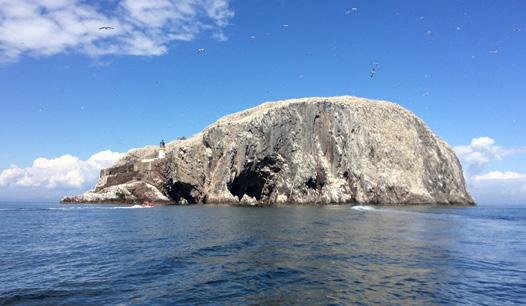
It’s not always been this way though. If you’re ever lucky enough to journey to the Bass by boat, look closely and you can still see the scattered remains and traces of hundreds of years of human activity.
The earliest recorded owners of the Bass are the Lauder family, to whom the island was gifted by King Malcolm III in the 11th century. The crest on their heraldic arms is, appropriately, a gannet sitting upon a rock.
Halfway up the island lies the ruin of St Baldred’s Chapel, which is sited upon a holy hermit’s cell (or cave) in which this Scottish Saint reputedly spent time. The Church retained this part of the island until the 14th century, when it was granted to the family, and the chapel was subsequently rebuilt.
Mud In Your Eye is published by East Lothian Council’s Countryside Rangers Welcome to the 60th Edition of Mud in Your Eye. In this issue: 2 3 We’d love to hear from you! Email ranger@eastlothian.gov.uk or follow us... @ELCrangers @elcrangers East Lothian Council Countryside Rangers The Bass Rock Geology: Plate Tectonics Hawk moths Stevenson Lighthouses of the Firth of Forth Heavens Above Quick Crossword Poetry: ‘Winter’, by RL Stevenson Cryptic Crossword East Lothian Countryside Volunteers Diary 3 - 5 6 - 7 8 - 9 10-12 13 14 15 16 17
Welcome The Bass Rock
Mud In Your Eye November - December ‘22
The Bass Rock (continued)
The Lauders also built a castle, the ruins of which can still be seen, not far above the island’s only landingplace. The buildings were constructed from local basalt over a series of years, with a curtain wall, round bastions, battlemented parapets and a ruined round tower still visible. The bastion keep and living quarters were taken down to provide stone for the lighthouse in 1902.
The 15th-century Scottish philosopher and historian Hector Boece gave the following description: “ane wounderful crag, risand within the sea, with so narrow and strait hals [passage] that na schip nor boit bot allanerlie at ane part of it. This crag is callet the Bas; unwinnabil by ingine [ingenuity] of man. In it are coves, als profitable for defence of men as [if] thay were biggit be crafty industry. Every thing that is in that crag is ful of admiration and wounder.”
Records show that in 1497 when King James IV visited the Bass and stayed in the castle with Robert Lauder, the boatmen who conveyed the King from Dunbar were paid 14 shillings; while, in 1581, when King James VI visited he was so enamoured that he tried (and failed) to buy the island.
Earlier, King James I had consigned several of his political enemies to imprisonment on the Bass, including many prominent members of the rebellious Clan Mackay. It would be used again as a notorious gaol following
Cromwell’s invasion in the 17th century, with many Covenanters sent here, including Alexander Shields, who later described the Bass as:
“a dry and cold rock in the sea, where they had no fresh water nor any provision but what they had brought many miles from the country, and when they got it, it would not keep unspoiled”
The experiences of the Covenanters on the Bass – some of whom were executed following their imprisonment –is movingly recalled in James Robertson’s popular novel The Fanatic (2000).
An extraordinary chapter in the Bass Rock’s history was its seizure by four Jacobite officers imprisoned in its castle, which they then held against government forces for nearly three years, 1691–1694 – an episode later chronicled in the historical novel Fortress in the Forth (1950).
Its inaccessibility became to mean something impossible, with the local saying: “Ding doun Tantallon —Mak a brig to the Bass.”
The Bass Rock features in many works of fiction, including Catriona by Robert Louis Stevenson, The Lion is Rampant by Ross Laidlaw and The New Confessions by William Boyd. Bruce Marshall used Bass Rock as the miraculous destination of ‘the Garden of Eden’, a dance hall of dubious repute in his 1938 novel Father Malachy’s Miracle Most recently it features prominently in Evie Wyld’s award-winning The Bass Rock (2020), a multi-generational gothic novel set in North Berwick.
himself with listening; so many still, hollow noises haunted and reverberated in the porches of the rock.”
Stevenson himself had connections with the island, as his cousin David Stevenson designed the lighthouse there, and he holidayed as a child at Scoughall Farm, by Tantallon, overlooking the Bass.
Catriona is Stevenson’s 1893 sequel to Kidnapped, with both novels set in the aftermath of the Jacobite risings. The hero of the story is once again kidnapped and confined on the Bass Rock.
Chapter XIV is entitled simply The Bass, and gives a long description of the island, which is described as “just the one crag of rock, as everybody knows, but great enough to carve a city from”
“It was an unco place by night, unco by day; and there were unco sounds; of the calling of the solans [gannets], and the plash [splash] of the sea, and the rock echoes that hung continually in our ears. It was chiefly so in moderate weather. When the waves were anyway great they roared about the rock like thunder and the drums of armies, dreadful, but merry to hear, and it was in the calm days when a man could daunt
The natural history of the rock was first recorded 500 years ago in John Mair’s De Gestis Scotorum (The Deeds of the Scots), published in 1521. Later, during the 16th and 17th centuries, records show that there was sufficient grass present for 100 sheep to graze on the Bass. A freshwater well at the summit, where today’s foghorn is situated, provided freshwater for the island’s occupants. The soil was actually relatively fertile, supporting a wide variety of plants, including the rare Bass mallow. The Covenanter James Fraser described eating fruit from the island’s cherry trees in the late 1600s.
By the 1800s, the gannet or ‘solan goose’ was being hunted for their eggs and the flesh of their young chicks, which were considered delicacies. It’s estimated that in 1850 alone almost 2,000 birds were harvested from the rock.
Nowadays, Morus bassanus reigns supreme, and the ghostly white veil of gannet droppings that covers the Bass hides a chequered past, enveloping the human traces that have shaped the island over the centuries. It also reminds us of nature’s innate ability to recover and reclaim, even in the darkest of moments.
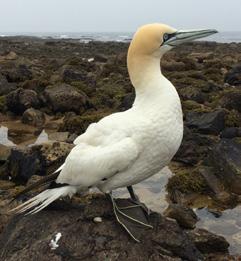
4 5The Bass Rock The Bass Rock
A Gannet on The Bass Rock
Plate Tectonics

The ground beneath our feet is not as solid or stable as we might like to imagine it.
The Earth’s crust is thin, making up less than 1% of the total volume and is made up of a series of plates. These plates are in constant motion, driven by convection currents within the upper mantle – the (sort of) molten layer directly below. This idea underpins the modern science of geology and is known as the Theory of Plate Tectonics.
concept of Continental Drift – the idea that continents are able to move around the globe and had occupied different positions in the past. Although the evidence for drift was plentiful, the idea was initially rejected because no convincing mechanism could be identified.
below another and is melted in the mantle. With this discovery, the pieces of the theory fell into place.
Furthermore, in this model, the continents sit on the heavier oceanic crust and are carried along with the latter’s movement, thus their relative positions can be explained without reference to vague ideas of “drift”.
subducted beneath the other. Where continental plates converge mountain chains are formed, as the rocks are folded, compressed and forced upwards. Transform plate margins occur when plates move sideways against each other. Probably the most well-known of these is along the San Andreas Fault, the meeting of the North American and Pacific plates.

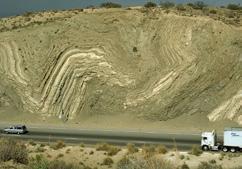
As early as the 16th century it had been noted the some of the continents seem to almost fit together, despite being separated by miles of ocean. The most obvious example is the east coast of South America and the west coast of Africa (or “Brazil having its nose up Africa’s bum”, as I once heard it described). This observation led, in the early twentieth century, to the
Oceanographic studies later established the existence of mid-ocean ridges in the Atlantic and elsewhere. It was found that the sea-floor was actually spreading from these ridges, with magma upwelling from below creating new oceanic crust. So far so good, but this formation of new sea-floor would imply that the earth is expanding. Weird.
However, it was also realised that oceanic crust was actually being destroyed elsewhere. Deep sea trenches were identified as areas in which one section of crust passes
Plate margins – where two or more plates meet - come in three types:
Divergent, Convergent and Transform.
Divergent margins, where plates move apart, produce the sea-floor spreading described above, or can create rift valleys when they coincide with continental land masses. Convergent margins are where plates move towards each other. In oceanic areas these lead to the deep trenches and are known as subduction zones, as one plate is
Although the movement involved is incredibly slow, in practice the effects of plate tectonics can be enormous and devastating. Plate margins can be volatile places, prone to earthquakes, tsunamis, volcanic eruptions and landslides.
We’re fortunate that the UK is positioned well away from plate margins at present, although it hasn’t always been that way – but more about that next time.
The Himalayas – formed by the Indian and Asian plates colliding

6 7Geology
Geology
Illustration: The earth’s major techtonic plates © US Geological Survey
Types of plate boundary
Folding of rocks along the San Andreas Fault
Hawk-moths

Unobtrusively going about their business throughout year, the sheer variety, cryptic patterns and unobtrusive habits of moths can be quite a group to get to grips with. Luckily one genus has true star quality and offers an easy ID if you are lucky enough to see one.
Hawk moths, so named due to their swiftness of flight and the hovering ability of certain species are present throughout much of the year, with 9 resident species occurring in the UK, though most with a significantly southern distribution, and a further 9 occurring as migrants.
Migrant species occur only when favourable southerly winds assist in transporting these adept fliers from the continent, some of whose wingspans almost equal that of our smallest birds.
At the more compact end of the scale, day-flying hummingbird hawk moths are a joy to see in summer as they zig-zag along flower beds before suspending themselves as they sup sweet nectar
through their long unfurled proboscises.
Conversely, historically regarded as a portent of doom, the large and rare migrant deaths-head hawk moth sports a skull like image on its thorax. It is likely this pattern has evolved to fox bees rather than freak us in that alongside the use of pheromones, the pattern possibly helps the moth placate suspicious bees that encounter this voracious and impressive honey thief. Winnie the pooh eat your heart out!
Other species more commonly occurring are best encountered through attending a moth trapping event in the summer where you can get great view of the bright pink tones

of the appropriately named elephant and small elephant hawk moths, or the pastel shades of the large and well camouflaged poplar hawk moth. But even as the nights draw in, there’s a chance of a vagrant hawk moth near Halloween and if you are extra lucky it’ll be one in spooky guise.
Above: This deaths-head moth was found recently in a garden shed in Dunbar, only one or two records occur in Scotland each year. Gruesomely it abdomen has been eaten by another insect revealing the eggs which may have been destined for a potato plant, a favoured food of the caterpillar.
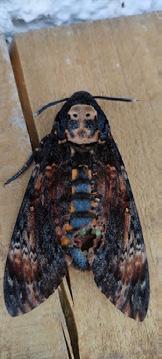
8 9Wild Life Wild Life
Elephant Hawk Moth Main photo: Poplar Hawk Moth on Finger
Death’s Head Moth © James Scott
The Stevenson Lighthouses of the Firth of Forth
by Nathan Bryceland
As autumn turns to winter, and the darker nights draw in, we’re reminded of the ever important role of lighthouses for the seafaring community in the Firth of Forth. But were you aware of the connection between these lighthouses and Robert Louis Stevenson?

The Stevenson family’s involvement in lighthouse engineering began with RLS’s grandfather, Robert Stevenson (1772-1850). Robert’s mother Jean Lillie (1751-1820) had married Thomas Smith (1753-1815) who was an engineer at the Northern Lighthouse Board.
The Board was founded in 1786 to “ensure the safety of the mariner and investigate new navigational technologies”, and still operates today (its offices are at 84 George Street in Edinburgh).
Robert Stevenson soon followed in his step-father’s professional footsteps, becoming his assistant, and from 17971843 chief engineer. During this time he oversaw the construction of many lighthouses, including the Bell Rock Lighthouse, the world’s oldest surviving sea-washed lighthouse.
Notably, Robert Stevenson invented intermittent and flashing lights, an invention which earned him a gold medal from the King of Netherlands. Although most well-known for his lighthouses, Robert also engineered bridges, roads, and railways, among other things.
In 1797, Robert married his step-sister Jean Smith (1779-1846). The couple had 13 children, but only 5 survived into adulthood. In 1798, when Robert was about 26, the family moved to a newly built townhouse, 2 Baxters Place, at the top of Leith Walk. In 1815, Robert’s stepfather died, and Robert inherited the house, where he continued to live until about 1820.
In 1816 Robert Stevenson designed and built a new lighthouse on the Isle of May. The original Isle of May light was sometimes hard to recognise – two large Royal Navy gunships were wrecked near Dunbar on the night of 19 December
1810 because their navigators had mistaken a lime kiln on the mainland coast for the beacon.
Stevenson’s new lighthouse was 25 metres high, an ornate gothic tower on a castellated stone building designed to resemble a castle, with accommodation for 3 light keepers and their families.
The May lighthouse is now a listed building, appearing in John Buchan’s 1934 novel The Free Fishers:

“Far out the brazier on the May was burning with a steady glow, like some lowswung planet shaming with its ardour the cold stars.”
staffed by 2 keepers until 1966; then a single keeper, until 1986, when it was completely automated. Finally, having been deemed surplus to requirements, it was deactivated and put up for sale in 2006.
David Alan Stevenson also built the 20-metre Bass Rock lighthouse in 1902, demolishing the 13th-century keep, or governor’s house, and some other buildings within the castle for the stone. The cost of constructing the Bass Rock light was £8,087. It has been unmanned since 1988.
Three of Robert’s sons, Alan (1807-1865), David (1815-1886) and Thomas (RLS’s father, 1818 – 1887) became lighthouse engineers as well. David worked in both Scotland and Japan, and his sons – David Alan Stevenson (1854-1938) and Charles Alexander Stevenson (1855-1950) –carried on the family name in lighthouse engineering.
However it was David A Stevenson’s first lighthouse design, in 1885, working in partnership with his uncle Thomas Stevenson, on the isle of Fidra, which holds most fascination for Stevenson fans.
Together they worked on the Barns Ness lighthouse, near Dunbar (1901). Taking approximately 2½ years to construct, it was built from stone quarried near Cramond. The stone proved resilient during WWII, when the lighthouse was machine-gunned yet sustained no damage. The lighthouse was
Robert Louis Stevenson (1850-1894) often visited the beaches at the area known today as Yellowcraig and it is said that he based his map of Treasure Island on the shape of Fidra. He also mentioned Fidra in his novel Catriona.
10 11Local History
Local History
Fidra Lighthouse
Barns Ness Lighthouse
Although Thomas Stevenson wished his son would become a lighthouse engineer, RLS knew he wanted to be a writer, and wrote later of the inspiration he found on the shores of the Firth of Forth:

“…a place sacred to the Muse… and I have there waited upon her myself with much devotion. This was when se, interested me only (if they interested me at all) as properties for some possible romance or as words to add to my vocabulary.”
mysterious aura. Since then, the number of breeding puffins on the island has increased due to the removal of an introduced plant, tree mallow ( Lavatera arborea ) – believed to have been planted by lighthouse keepers for use as toilet paper, and for its medicinal qualities. The island’s name is believed to be Old Norse in origin, referring to the large number of bird feathers found there.
Heavens Above
The planet Mars will be high and bright in the night sky during the coming months.

As it nears opposition - the point where it lies directly opposite the sun from our point of view - it will appear very close to the moon. In fact, if you are up very early on December 8th you can see the occultation of Mars by the moon. Occultation is really just a fancy way of saying that Mars becomes hidden by the moon passing in front of it. Mars will appear right next to the moon before disappearing behind it at about 4.55am and reappearing at the other side about an hour later. Believe it or not, a lot of amateur astronomers will be out to watch this spectacle!
During December, Mars will be in Taurus and therefore close to the two bright star clusters, the Hyades and Pleiades. These are well worth looking at through binoculars. The Pleiades in particular will show many more stars than its English name, The Seven Sisters, suggests.
The stars in the cluster are hot blue stars that have formed in the last 100 million years, making them a lot younger than our own star, the sun. They will eventually begin to move apart from each other over the next few million years due to the effects of local gravity.

There are a couple of meteor showers at this time. The Leonids peak on the 17th to 18th November and are associated with the comet TempelTuttle. The Geminids peak on the 14th to 15th December and are one of only two showers that don’t originate from a comet. The meteor shower is thought to be linked to an asteroid called Phaethon. To see either of these you will need fairly dark skies and some patience, although as many as 120 meteors per hour have been recorded for the Geminids in recent years.
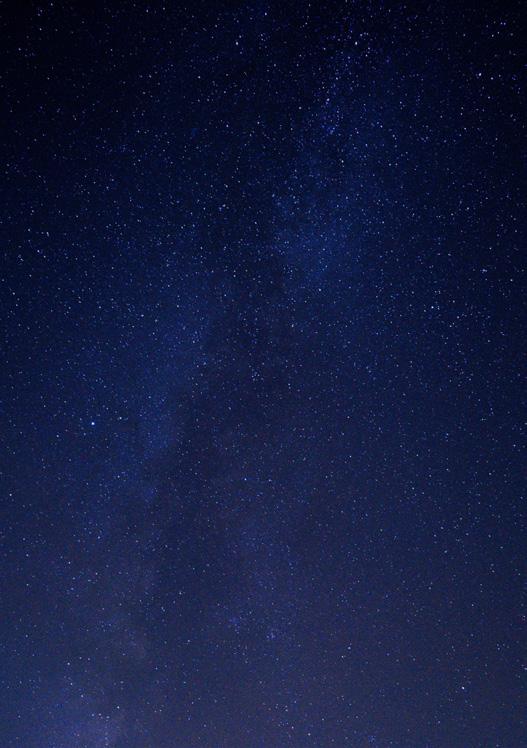
Later in the 20th century, Fidra became the first unmanned lighthouse in Scotland, somehow adding to its
They say that birds of a feather flock together, and in their shared passion for lighthouses and the islands of the Firth of Forth, the Stevenson family combined to contribute a lasting legacy that will shine on for generations to come.

12 13Local History Heavens Above
Stevenson Lighthouses of the Firth of Forth (continued)
Above, the planet Mars Right - The Pleiades
Main image: Bass Rock Lighthouse Inset: Isle of May Lighthouse
Quick(ish!) Crossword
Winter-Time
by RL Stevenson
Late lies the wintry sun a-bed, A frosty, fiery sleepy-head; Blinks but an hour or two; and then, A blood-red orange, sets again.
Before the stars have left the skies, At morning in the dark I rise; And shivering in my nakedness, By the cold candle, bathe and dress.
Close by the jolly fire I sit To warm my frozen bones a bit; Or with a reindeer-sled, explore The colder countries round the door.

When to go out, my nurse doth wrap Me in my comforter and cap; The cold wind burns my face, and blows Its frosty pepper up my nose.
Black are my steps on silver sod; Thick blows my frosty breath abroad; And tree and house, and hill and lake, Are frosted like a wedding cake.
14 15Crossword Corner
The answers here are the same as the Cryptic Crossword (p14) – so if you get stuck you could always look at those clues! You can also click HERE to complete online. (The solution is on p17) Across 6 Duck (7) 7/22 Runs 15 (7,7) 9 Hills in Edinburgh (5) 10/26 Musselburgh coast (9,5) 11 On Tibet/Nepal border (7) 13 Insect with loud song (6) 15 For 8-12 year-olds (6,7) 20 Llama (6) 22 See 7 25 Person of no influence (9) 26 See 10 28 E.g. elephants, wild boars (7) 29 Polar regions (7) Down 1 You should be a member of this (4) 2 Sandwich (6) 3 Flattering (9) 4 Electron microscope, for example (8) 5 Yellow tropical fruit (6) 6 Mollusc (6) 7 Night-long dance party (4) 8 Triangular alluvial deposits (6) 12 Flightless bird (3) 14 Non-dangerous clasp (6,3) 16 Angered (8) 17 Got from too much mouse usage (3) 18 Tree (6) 19 Type of monkey (6) 21 Penalise (6) 23 Plover or Oriole (6) 24 Fruit seeds (4) 27 Not far (4)
Poetry
Maintaining the link to the Stevenson family, here is a poem written by Robert Louis Stevenson about winter.
Nobody is ninety and not
(9)
night dancing (4)
8 Greek letters at river mouths (6)
Volunteer
Dates
10
They have very long teeth and
rusks without a problem (7)
29 Space returns to the end of cosmic cold areas (7)
12 Well up in numeracy but can’t fly (3)
14 Fasten? Yip! (6,3)
Some royal - even hallowed
ground connects
coast (9,5)
Severe confusion on Tibet/ Nepal border (7)
The heads of these creepy insects create a din - actually it’s not, it’s the tymbals! (6)
Jungian errors corrected for kids outdoors (6,7)
lama? Perhaps a camel? All leads to this! (6)
7
Down
1 Council helper may undo velcro, or not (4)
2 South African registered nurse that is making a sandwich (6)
3 Laudatory, possibly flattering (9)
4 Digitising, intensely examining (8)
5 Mostly happy with a cocktail and a fruit (6)
6 Mollusc sounds strong (6)
7 Rear view regularly seen all
16 Was angry but smelled better after this (8)
17 Middle of wrist hurt? (3)
18 Tree tops were always lovelynow ugly topiary (6)
19 Monkey rushes around (6)
21 Penalise word play - I say be quiet (6)
23 Longed to become slightly brown (6)
24 Is very quiet - oddly found in fruit (4)
27 It’s not far from the Gullane area (4)
Where Day Date Time Action
Yellowcraig
Thu 3 Nov 10:00-15:00 Site maintenance
North Berwick Thu 10 Nov 10:00-12:30 Strimming and cutting back
Levenhall Links Tue 29 Nov 10:00-13:00 Site maintenance
Dunbar Wed 30 Nov 10:00-13:00 Strimming, scything and raking
Yellowcraig Thu 1 Dec 10:00-15:00 Site maintenance
North Berwick Tue 8 Dec 10:00-12:30 Site maintenance
Levenhall Links Tue Dec 10:00-13:00 No task
Dunbar Wed Dec 10:00-13:00 No task
16
Volunteer Diary Dates
Diary
For information on all events please contact ranger@eastlothian.gov.uk Crossword Solution Remember to save the date! We’d love to hear from you! Email us at ranger@eastlothian.gov.uk or follow us... @ELCrangers @ELCrangers East Lothian Council Countryside Rangers Get in touch Crossword CornerCrossword Cryptic Crossword The answers here are the same as the Quickie Crossword (p13) – so if you get stuck you could always look at those clues! You can also click HERE to complete online. (The solution is on p17) Across 6 It’s wrong in Paris to add fat to duck (7) 7/22 Childish ranger matures and looks after 15 children (7,7) 9 Strangely it’s not odd after six (5) 10/26
-
Musselburgh
11
13
15
20 A
22 See
25
confused
26 See
28
eat





















